Identification of Major Inefficient Water Consumption Areas Considering Water Consumption, Efficiencies, and Footprints in Australia
Abstract
1. Introduction
What are the major water consumption sectors and how can the water footprint help in reducing the water accounting-related vulnerabilities in Australia by identifying the most detrimental sector?
1.1. Freshwater Availability in Australia
1.2. Major Water Consumption Sectors
2. Water Footprint Accounting
2.1. Domestic Water Consumption Accounting
2.2. Industrial Water Consumption Accounting
2.3. Agricultural Footprints
- • Cotton
- • Rice
- • Sugar cane
- • Grapevines
2.4. Detailed Investigation of Agricultural Practices
2.4.1. Comparison of Cotton
2.4.2. Rice Comparison
2.4.3. Sugar Cane Comparison
2.4.4. Grape Comparison
2.5. Irrigation Practices
3. Analysis of Virtual Water Trade
4. Conclusions and Recommendations
Author Contributions
Funding
Conflicts of Interest
References
- Worldometers, Global Water Use. 2019. Available online: https://www.waterscarcitysolutions.org/ (accessed on 11 December 2019).
- World Water Assessment Programme. Managing Water Under Uncertainty and Risk; United Nations Educational Scientific and Cultural Organization: Paris, France, 2012. [Google Scholar]
- Mekonnen, M.M.; Hoekstra, A.Y. Sustainability: Four billion people facing severe water scarcity. Sci. Adv. 2016, 2, e1500323. [Google Scholar] [CrossRef] [PubMed]
- Bureau of Meteorology, Recent Rainfall, Drought and Southern Australia’s long-Term Rainfall Decline, 2015. Available online: http://www.bom.gov.au/climate/updates/articles/a010-southern-rainfall-decline.shtml#toc1 (accessed on 5 October 2018).
- Bureau of Meteorology, Indian Ocean influences on Australian Climate, 2018. Available online: http://www.bom.gov.au/climate/iod/ (accessed on 11 October 2018).
- FAO. The State of the World’s Land and Water Resources for Food and Agriculture (SOLAW)–Managing Systems at Risk; The Food and Agriculture Organization of the United Nations and Earthscan: New York, NY, USA.
- FAO AQUASTAT Global Information System of Water and Agriculture: Rome, Italy, 2012. Available online: http://www.fao.org/aquastat/en/ (accessed on 2 September 2020).
- Hoekstra, A.C.A. Water footprints of nations: Water use by people as a function of their consumption pattern. Water Resour. Manag. 2007, 21, 35–48. [Google Scholar] [CrossRef]
- Department for Environment and Water, Efficiency Measure projects in South Australia, Government of South Australia for Environment and Water. 2017. Available online: https://www.environment.sa.gov.au/topics/river-murray/basin-plan/efficiency-measure-projects (accessed on 1 December 2019).
- Water services Association of Australia (WSAA). Water Efficient Australia, Smart Approved WaterMark; Water Services Association of Australia (WSAA): Canberra, Australia, 2019; Available online: https://www.wsaa.asn.au/publication/water-efficient-australia (accessed on 10 December 2019).
- Water Foot Print Network, Global Water Footprint Standard, 2011. Available online: https://waterfootprint.org/en/water-footprint/global-water-footprint-standard/ (accessed on 17 December 2019).
- Hoekstra, A.Y.; Chapagain, A.K. The water footprints of Morocco and the Netherlands: Global water use as a result of domestic consumption of agricultural commodities. Ecol. Econ. 2007, 64, 143–155. [Google Scholar] [CrossRef]
- Yu, Y.; Hubacek, K.; Feng, K.; Guan, D. Assessing regional and global water footprints for the UK. Ecol. Econ. 2010, 69, 1140–1147. [Google Scholar] [CrossRef]
- Feng, K.; Hubacek, K.; Minx, J.; Siu, Y.L.; Chapagain, A.; Yu, Y.; Guan, J. Barrett, Spatially Explicit Analysis of Water Footprints in the UK. Water 2010, 3, 47–63. [Google Scholar] [CrossRef]
- Cai, B.; Liu, B.; Zhang, B. Evolution of Chinese urban household’s water footprint. J. Clean. Prod. 2019, 208, 1–10. [Google Scholar] [CrossRef]
- Liu, X.; Shi, L.; Engel, B.A.; Sun, S.; Zhao, X.; Wu, P.; Wang, Y. New challenges of food security in Northwest China: Water footprint and virtual water perspective. J. Clean. Prod. 2020, 245, 245–118939. [Google Scholar] [CrossRef]
- Zhang, S.; Taiebat, M.; Liu, Y.; Qu, S.; Liang, S.; Xu, M. Regional water footprints and interregional virtual water transfers in China. J. Clean. Prod. 2019, 228, 1401–1412. [Google Scholar] [CrossRef]
- Zhai, Y.; Shen, X.; Quan, T.; Ma, X.; Zhang, R.; Ji, C.; Zhang, T.; Hong, J. Impact-oriented water footprint assessment of wheat production in China. Sci. Total Environ. 2019, 689, 90–98. [Google Scholar] [CrossRef] [PubMed]
- Xie, X.; Jiang, X.; Zhang, T.; Huang, Z. Study on impact of electricity production on regional water resource in China by water footprint. Renew. Energy 2020, 152, 165–178. [Google Scholar] [CrossRef]
- Mekonnen, M.M.; Hoekstra, A.Y. National Water Footprint Accounts: The Green, Blue and Grey Water Footprint of Production and Consumption; UNESCO-IHE: Delft, The Netherlands, 2011. [Google Scholar]
- The Wold Bank, Industry (including Construction), Value Added (Constant 2010 US$), 2018. Available online: https://data.worldbank.org/indicator/NV.IND.TOTL.KD?view=chart (accessed on 18 September 2018).
- Prosser, I. Current Water Availability and Use; Csiro: Melbourne, Australia, 2011. [Google Scholar]
- BOM, Water in Australia -Australian Government—Bureau of Meteorology, BOM, 2018–2019. Available online: http://www.bom.gov.au/water/waterinaustralia/ (accessed on 25 December 2019).
- Index Mundi, Australia—Renewable Internal Freshwater Resources per Capita (cubic meters), 2015. Available online: https://www.indexmundi.com/facts/australia/indicator/ER.H2O.INTR.PC (accessed on 15 December 2019).
- Hugo, G. Changing Patterns of Population distribution in Australia. J. Popul. Res. Spec. Ed. 2002. Available online: https://search.informit.com.au/documentSummary;dn=395273573294486;res=IELAPA (accessed on 2 September 2020).
- The Role of Water in Australia’s Uncertain Future. The Conversation 2015. Available online: https://theconversation.com/the-role-of-water-in-australias-uncertain-future-45366 (accessed on 24 June 2019).
- Australian Food History Timeline, 2001—2008 Millennium Drought, 2011. Available online: https://australianfoodtimeline.com.au/millennium-drought/ (accessed on 1 December 2019).
- The World Bank, Agriculture, Forestry, and Fishing, Value Added (Current US$), 2018. Available online: https://data.worldbank.org/indicator/NV.AGR.TOTL.CD?end=2017&start=2017&view=bar (accessed on 14 September 2018).
- UNSW-Sydney Connected Waters Initiative, Connected Waters, 10 September 2007. Available online: http://www.connectedwaters.unsw.edu.au/articles/2007/09/national-water-footprints (accessed on 28 November 2019).
- Fader, M.; Gerten, D.; Thammer, M.; Heinke, J.; Lotze-Campen, H.; Lucht, W.; Cramer, W. Internal and external green-blue agricultural water footprints of nations, and related water and land savings through trade. Hydrol. Earth Syst. Sci. Discuss. 2011, 8, 483–527. [Google Scholar] [CrossRef]
- Australian Bureau of Statistics, Australian Demographic Statistics, Jun 2016, 2017. Available online: http://www.abs.gov.au/AUSSTATS/abs@.nsf/Lookup/3101.0Main+Features1Jun%202016?OpenDocument (accessed on 1 September 2018).
- Australian Bureau of Statistics, Water Account, Australia, 2015–16, 2017. Available online: http://www.abs.gov.au/AUSSTATS/abs@.nsf/allprimarymainfeatures/49F854E3831E4294CA2580580015E2A6?opendocument (accessed on 30 August 2018).
- Hoekstra, A.Y.; Chapagain, A.K.; Aldaya, M.M.; Mekonnen, M.M. The Water Footprint Assessment Manual: Setting the Global Standard; Earthscan: London, UK, 2011. [Google Scholar]
- Australian Bureau of Statistics, Australian National Accounts: State Accounts, 2015–16, 2017. Available online: http://www.abs.gov.au/AUSSTATS/abs@.nsf/allprimarymainfeatures/8DEE81B03A2C2842CA2581DA000F4790?opendocument (accessed on 5 September 2018).
- Power and Water Corporation, the Darwin Water Story, 2013. Available online: https://www.powerwater.com.au/__data/assets/pdf_file/0011/1523/Darwin_Water_Story_2013.PDF (accessed on 23 September 2019).
- Redhead, M. Melbourne Residential Water End Uses Winter 2010; summer 2012; Smart Water Fund: Melbourne, Australian, 2013. [Google Scholar]
- Griffith University, School of Engineering and Smart Water Research Centre, South East Queensland Residential End Use Study: Baseline Results—Winter 2010, Urban Water Security Research Alliance, City East, 2010. Available online: http://hdl.handle.net/10072/38126http://www.urbanwateralliance.org.au/publications/UWSRA-tr31.pdf (accessed on 25 September 2019).
- Rickwood, P.; Giurco, D.; Glazebrook, G.; Kazaglis, A.; Thomas, L.; Zeibots, M.; Boydell, S.; White, S. Integrating Population, Land Use, Transport, Water and Energy-Use Models to Improve the Sustainability of Urban Systems; University of Technology Sydney: Sydney, Australia, 2007. [Google Scholar]
- TeamPoly, Water Price in Australia, 2018. Available online: https://www.teampoly.com.au/2018/06/15/water-prices-in-australia/ (accessed on 2 December 2019).
- Averink, J. Global Water Footprint of Industrial Hemp Textile; University of Twente: Enschede, The Netherlands, 2015. [Google Scholar]
- Department of the Environment and Energy. Australian Energy Statistics: Table O; Department of the Environment and Energy: Canberra, Australia, 2018. [Google Scholar]
- ABARES, Agricultural Commodities, 2019. Available online: http://www.agriculture.gov.au/abares/research-topics/agricultural-commodities (accessed on 3 May 2019).
- ABARES, Food Consumption and Imports, 2018. Available online: https://public.tableau.com/profile/australian.bureau.of.agricultural.and.resource.economics.and.sci#!/vizhome/FooddemandinAustralia/Indicators-fig3 (accessed on 2 May 2019).
- PMSEIC Expert Working Group. Australia and Food Security in a Changing World; Australian Government: Canberra, Australia, 2010. [Google Scholar]
- Chini, M.; Konar, M.; Stillwell, A.S. Direct and indirect urban water footprints of the United States. Water Resour Res. 2016, 53, 1. [Google Scholar]
- Department of Agriculture Water and the Environment, about My Region-Northern Territory, Department of Agriculture Water and the Environment, 4 February 2020. Available online: https://www.agriculture.gov.au/abares/research-topics/aboutmyregion/nt (accessed on 19 December 2019).
- Australian Bureau of Statistics, Irrigation on Australian farms, 1301.0—Yearbook Chapter, 2008, 2008. Available online: https://www.abs.gov.au/AUSSTATS/abs@.nsf/Previousproducts/1301.0Feature%20Article16012008?opendocument&tabname=Summary&prodno=1301.0&issue=2008&num=&view= (accessed on 18 February 2020).
- Frontier Economics. The Concept of ‘Virtual Water’—A Critical Review; The Frontier Economics Network: Melbourne, Australia, 2008. [Google Scholar]
- Mekonnen, M.M.; Hoekstra, A.Y. Value of Water Research Report Series No. 47; UNESCO-IHE: Delft, The Netherlands, 2010. [Google Scholar]
- Mekonnen, M.M.; Hoekstra, A.Y. Value of Water Research Report Series No. 48; UNESCO-IHE: Delft, The Netherlands, 2010. [Google Scholar]
- Roth, G.; Harris, G.; Gillies, M.; Montgomery, J. Water-Use Efficiency and Productivity Trends in Australian Irrigated Cotton: A Review; Crop and Pasture Science: Collingwood, Australia, 2013; Volume 64, pp. 1033–1048. [Google Scholar]
- McNally, Alleged Barwon-Darling Water Thieves to be Prosecuted after ABC Investigation, 2018. Available online: https://www.abc.net.au/news/2018-03-08/nsw-water-theft-barwon-darling-government-prosecuting/9527364 (accessed on 16 May 2019).
- Ferguson, Cotton Grower Anthony Barlow Pleads Guilty to Illegal Pumping of Murray Darling Water, 2018. Available online: https://www.abc.net.au/news/2018-11-26/cotton-grower-pleads-guilty-to-mdb-illegal-pumping/10553990 (accessed on 12 May 2019).
- WaterSource, NSW Ombudsman Makes a Move on Murray-Darling Basin Water Thieves, 2018. Available online: https://watersource.awa.asn.au/environment/natural-environment/nsw-ombudsman-makes-a-move-on-murray-darling-basin-water-thieves/ (accessed on 6 May 2019).
- Irrigation Australia, 2019. Available online: https://www.irrigationaustralia.com.au/about-us/types-of-irrigation/types-of-irrigation (accessed on 10 May 2019).
- Suh, S.; Lenzen, M.; Treloar, G.J.; Hondo, H.; Horvath, A.; Huppes, G.; Jolliet, O.; Klann, U.; Krewitt, W.; Moriguchi, Y.; et al. System Boundary Selection in Life-cycle Inventories Using Hybrid Approaches; Environmental Science & Technology: Bethesda, MD, USA, 2004; pp. 657–664. [Google Scholar]
- Weber, L.; Matthews, H.S. Quantifying the Global and Distributional Aspects of American Household Carbon Footprint. Ecol. Econ. 2008, 66, 379–391. [Google Scholar] [CrossRef]
- WFN, Water Footprint: Introduction, 2008. Available online: https://www.waterfootprint.org/en/ (accessed on 21 February 2020).
- Water Footprint Network, Aims & History, 2018. Available online: http://waterfootprint.org/en/about-us/aims-history/ (accessed on 15 August 2018).
- Feng, K.; Chapagain, A.; Suh, S.; Pfister, S.; Hubacek, K. A Comparison of Bottom-Up and Top-Down Approaches to Calculating the Water Footprints of Nations; Routledge-Taylor and Francis Group: London, UK, 2011; Volume 23, pp. 371–385. [Google Scholar]
- Minx, J.C.; Weber, C.L.; Edenhofer, O. Growth in Emission Transfers International Trade from 1990 to 2008; National Center for Biotechnology Information: Bethesda, MD, USA, 2011; Volume 108, p. 21. [Google Scholar]
- FAO. FAOSTAT, 05 May 2019. Available online: http://www.fao.org/faostat/en/#data/TP (accessed on 5 May 2019).
- DFAT Australia’s Trade Statistic at a Glance, 2018. Available online: https://dfat.gov.au/trade/resources/trade-at-a-glance/Pages/top-goods-services.aspx (accessed on 3 December 2019).
- Anderson, Fifty Years of Australia’s Trade, 12 2014. Available online: https://dfat.gov.au/about-us/publications/Documents/fifty-years-of-Australias-trade.pdf (accessed on 23 March 2019).
- Ministry of Commerce Country, Ministry of Commerce Country Report Trade Data and Australian Office of Commerce, 2017. Available online: http://www.mofcom.gov.cn/article/tongjiziliao/fuwzn/ckt (accessed on 4 May 2019).
- Ministry of Commerce Country Report Trade Data and Australian Office of Commerce, Overview of Australian Trade in Goods and Bilateral Trade between China and Australia. 2017. Available online: http://www.mofcom.gov.cn/article/tongjiziliao/fuwzn/ckt (accessed on 4 May 2019).
- Jackson, T.Z.K. Snapshot of Australian Agriculture; ACT 2601; Australian Bureau of Agricultural and Resource Economics and Sciences: Canberra, Australia, 2018. [Google Scholar]
- Reserve Bank of Australia, Chart Pack, Regions and Industry, 2019. Available online: https://www.rba.gov.au/chart-pack/regions-industry.html (accessed on 4 May 2019).
- Sherald, M. Australian’s the World’s Wealthiest, 2011. Available online: https://www.smh.com.au/lifestyle/australians-the-worlds-wealthiest-20111101-1mt2r.html (accessed on 13 March 2019).
- Australia Bureau of Statistics. Balance of Payments and International Investment Position; Australian Bureau of Statistics: Belconnen, Australia, 2014. [Google Scholar]
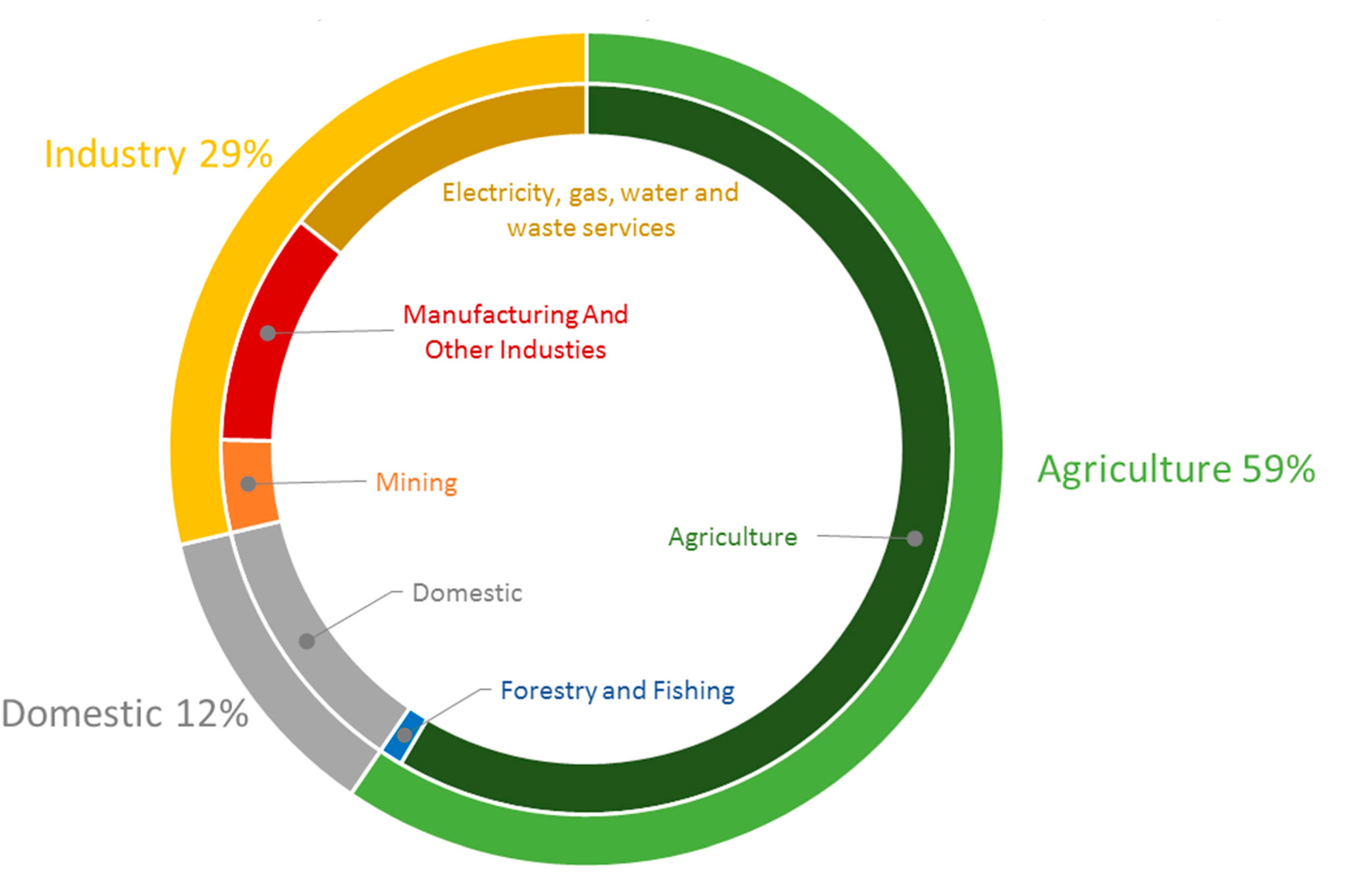
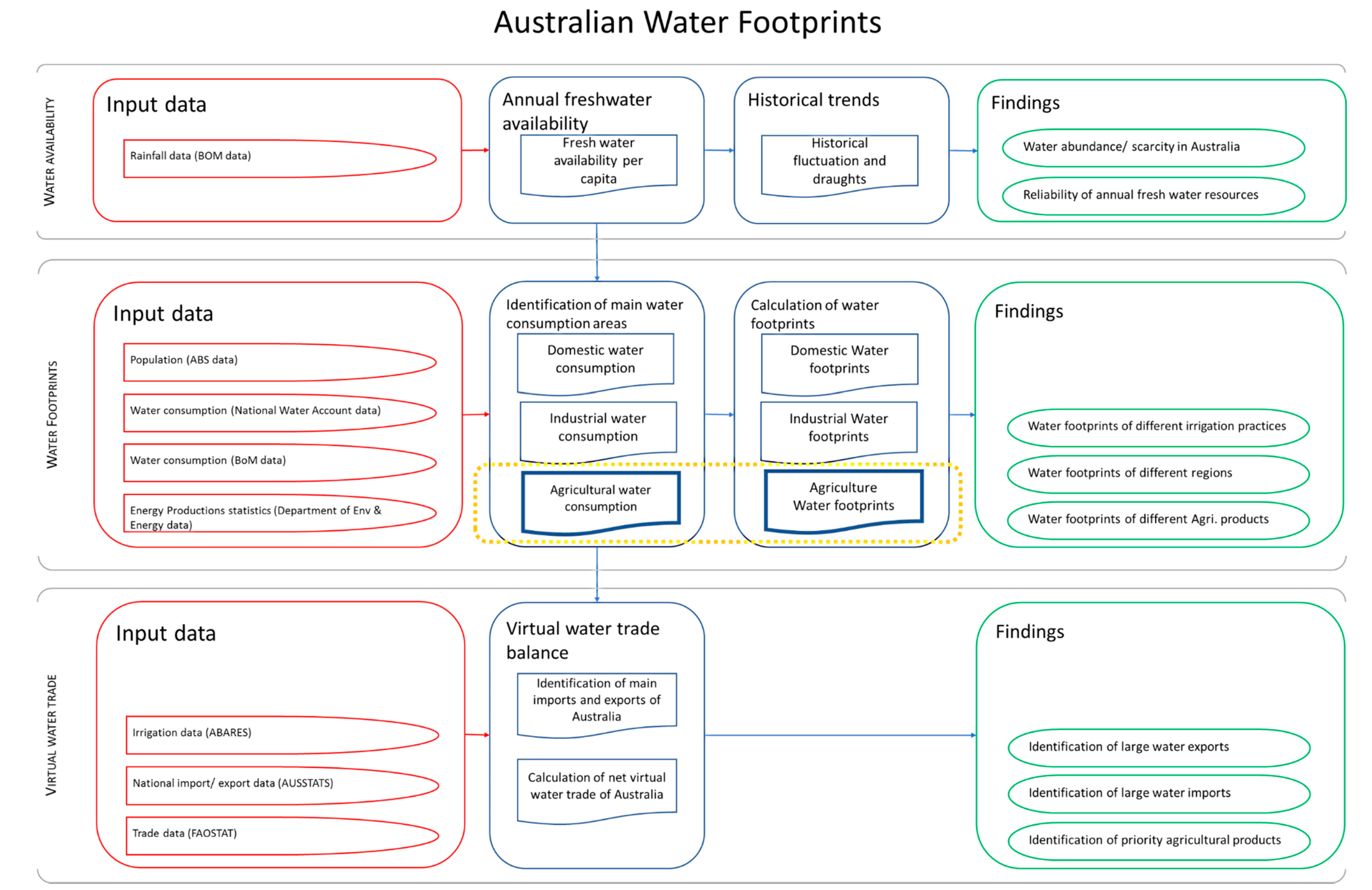
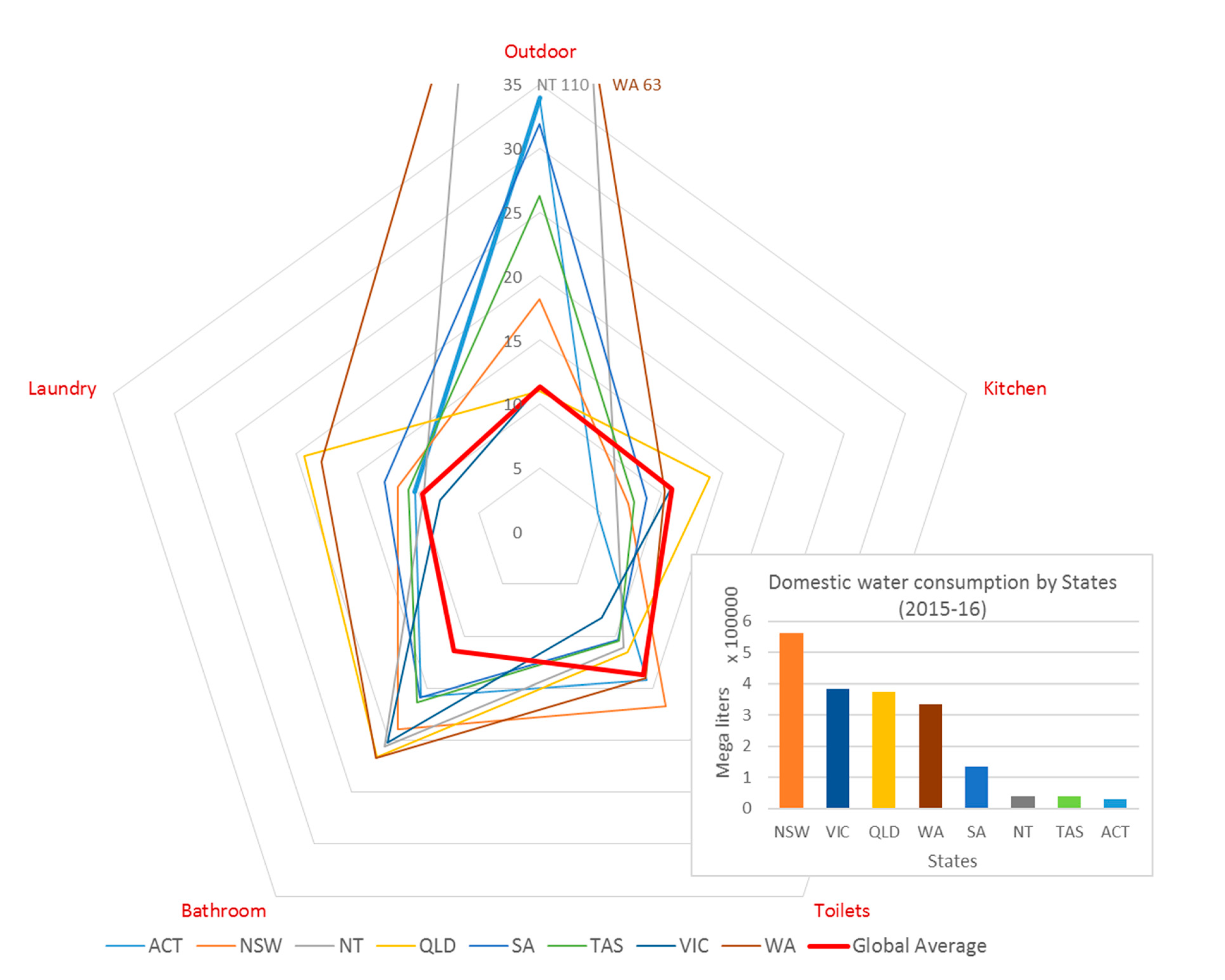

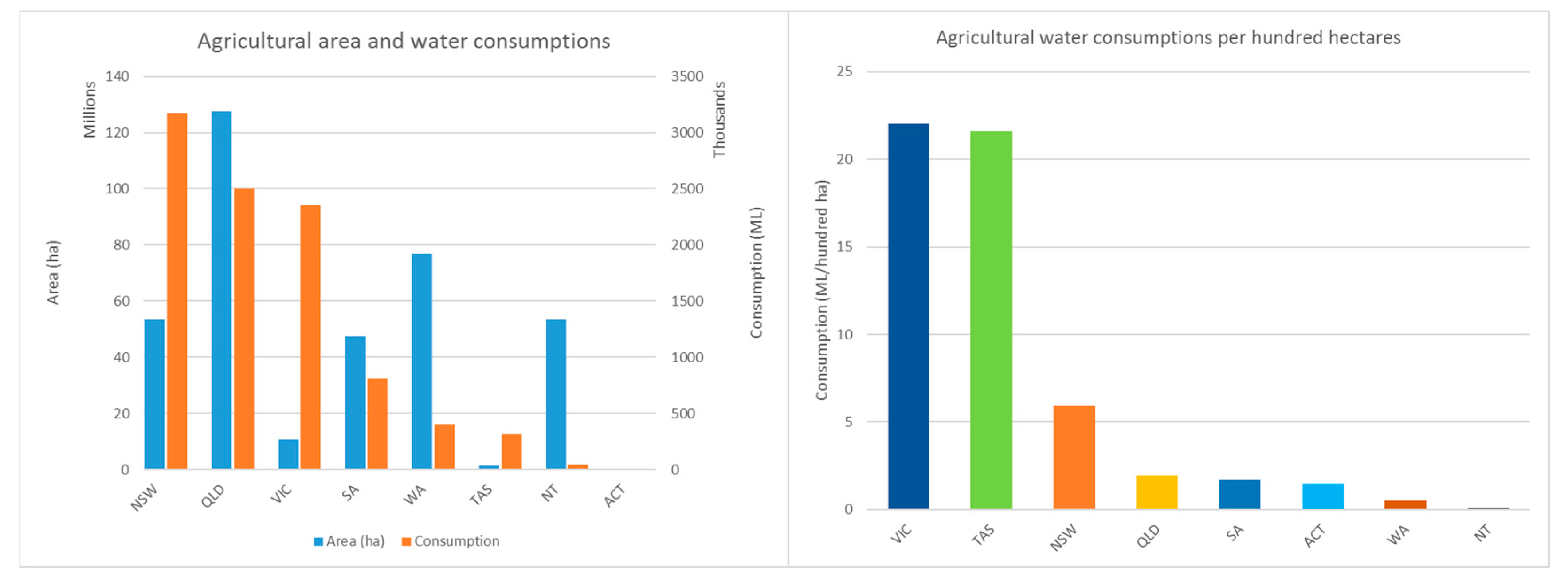
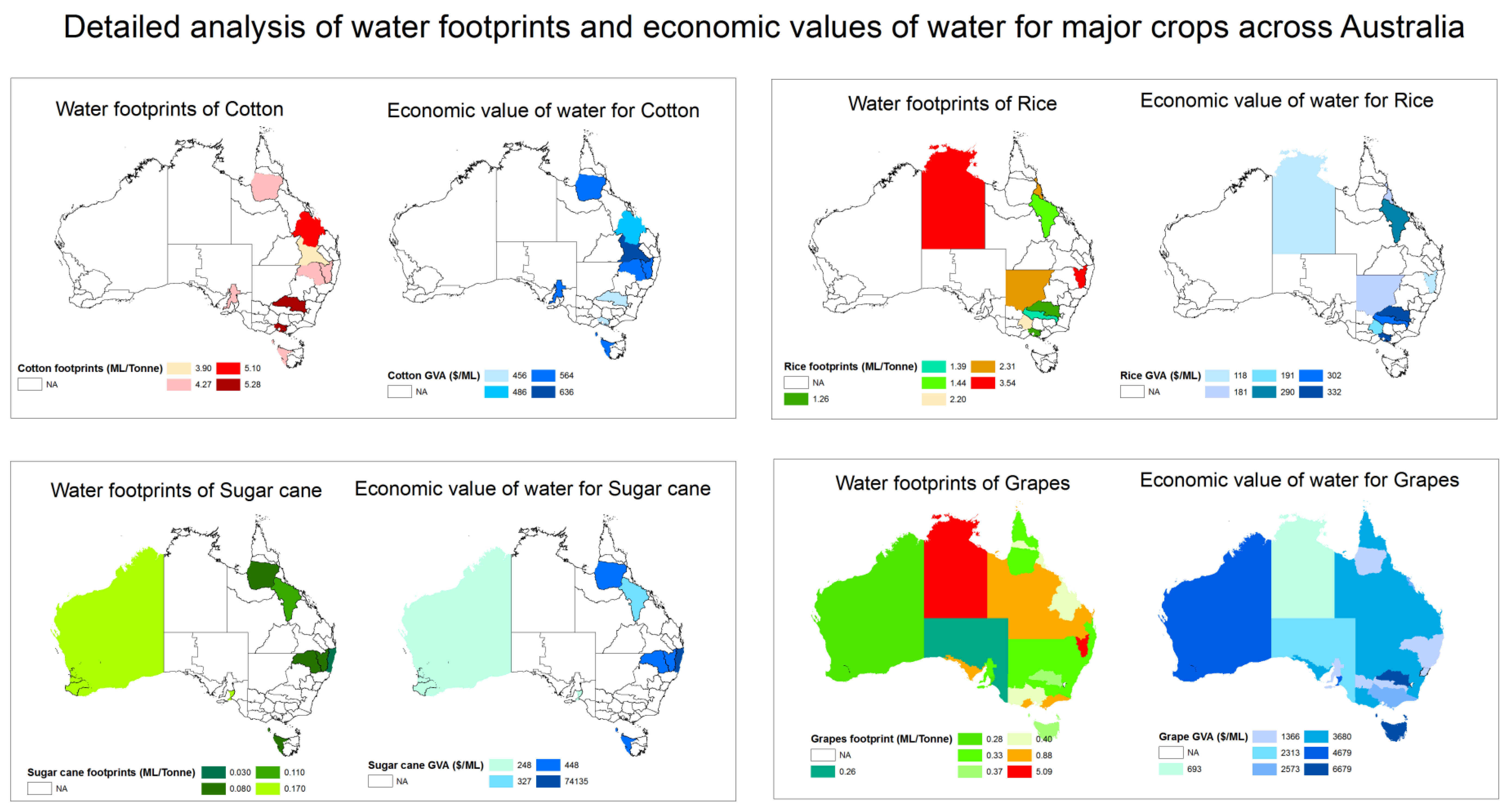
© 2020 by the authors. Licensee MDPI, Basel, Switzerland. This article is an open access article distributed under the terms and conditions of the Creative Commons Attribution (CC BY) license (http://creativecommons.org/licenses/by/4.0/).
Share and Cite
Tariq, M.A.U.R.; Damnics, R.R.; Rajabi, Z.; Shahid, M.L.U.R.; Muttil, N. Identification of Major Inefficient Water Consumption Areas Considering Water Consumption, Efficiencies, and Footprints in Australia. Appl. Sci. 2020, 10, 6156. https://doi.org/10.3390/app10186156
Tariq MAUR, Damnics RR, Rajabi Z, Shahid MLUR, Muttil N. Identification of Major Inefficient Water Consumption Areas Considering Water Consumption, Efficiencies, and Footprints in Australia. Applied Sciences. 2020; 10(18):6156. https://doi.org/10.3390/app10186156
Chicago/Turabian StyleTariq, Muhammad Atiq Ur Rehman, Riley Raimond Damnics, Zohreh Rajabi, Muhammad Laiq Ur Rahman Shahid, and Nitin Muttil. 2020. "Identification of Major Inefficient Water Consumption Areas Considering Water Consumption, Efficiencies, and Footprints in Australia" Applied Sciences 10, no. 18: 6156. https://doi.org/10.3390/app10186156
APA StyleTariq, M. A. U. R., Damnics, R. R., Rajabi, Z., Shahid, M. L. U. R., & Muttil, N. (2020). Identification of Major Inefficient Water Consumption Areas Considering Water Consumption, Efficiencies, and Footprints in Australia. Applied Sciences, 10(18), 6156. https://doi.org/10.3390/app10186156








